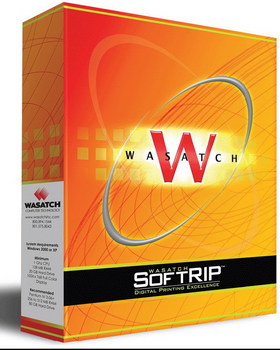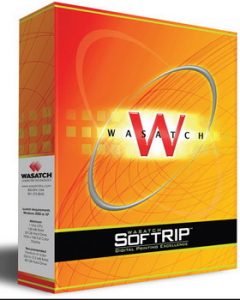Buying a RIP can be intimidating. The myriad menus and settings can often make space-shuttle controls seem simple. You have to choose: a standalone hardware RIP or a software package to run on your own hardware. What about color management? What about performance? What a nightmare.
Wasatch’s flagship product, SoftRIP, could be just the ticket. With more than 25 years of colorprinting experience, the company knows a thing or two. A pioneer of the digital-printing industry, it supplies software RIPs that can drive any printer, including desktop printers. The Sweet 16 in the title actually refers to a significant SoftRIP upgrade. We’ll examine that a little later.
If you’re considering a large-format digital printer or a RIP solution, keep reading. Loaded with features, the new SoftRIP 6.1 easily installs and might be your ticket out of printing hell.
Specifications
SoftRIP 6.1 is fairly easy to accommodate. Your hardware needs at least a 1GHz processor, 512MB of RAM and 8GB of free, hard-drive space. However, Wasatch recommends a Pentium IV 3GHz CPU with 1GB of RAM, and 80GB of free-disk space. System wise, SoftRIP 6.1 will run on Windows 2000, XP, or (ta da!) Vista. Yep, mark this down as the first package we’ve reviewed that works under Microsoft’s newest operating system.
Advertisement
Installation and setup
RIP installation and configuration can be very intimidating. With SoftRIP 6.1, however, you can print your first image in less than an hour. Protected by a USB dongle, the software requires an activation code for any purchased options. One CD holds the actual software, with additional printer drivers on supplementary disks.
To register online, click “register software” on the company’s webpage. Enter the software and passcode, and Wasatch will immediately e-mail you the code. It’s that simple.
With the RIP installed and activated, three simple steps remain. First, select your printer model. Wasatch supports a large list of printers; yours should be on the list. If not, go to www.wasatch.com, and click on the support tab. There, you can download additional color profiles.
Next, configure your printer. Use the setup menu, which will display the installed printer. Here, you’ll select the ink set, printer resolution, media width, margins and media type (vinyl, photo paper, etc.). Finally, configure the physical connection to your printer. This can be as simple as selecting a parallel port for a direct connection or, more likely, selecting the printer’s network. Once these steps are performed, you’re ready to print.
Using the RIP
Advertisement
The easy-to-use RIP can work as a standalone station, or it can be accessed over a network as a hot folder or via a built-in web interface. Up to four printers can be configured in the full version. In each instance, configuration was very easy.
We’ll concentrate on the RIP’s main user interface, which is designed around a large window that utilizes tabs and menu selections.
The job preparation window is divided into two main sections. The display’s left portion allows you to to enter job-specific settings, look at job and system information and browse for images.
Use the right window to manipulate the RIPed files, and as a clever layout window that lets you position images on the media. Here, you can scale, mirror, rotate and crop the image.
The menu bar offers a nice set of four nesting options. You can choose to minimize media waste, or select them for optimum trimming. Nesting-function results are displayed in the layout window in real time.
A tiling feature lets you print images that exceed the printer’s width. The user has full control of the tiles, and again, the layout window displays feedback. Click the Queue tab to get the status of the print queues, as well as the printing status.
Advertisement
Image quality
Now we can talk about the Sweet 16 party. Wasatch has added a 16-bit, image-processing pipeline to SoftRIP 6.1. So, what does that mean? Most RIPs handle images and image data with eight bits of pixel depth. Processing images with 16 bits of pixel depth increases the theoretical number of unique colors that can be displayed, within a given color gamut.
High-end, image-editing programs, such as Adobe Photoshop, can manipulate 16-bit images. But, when printed, images are typically downsized to eight bits. Significant color information can be lost.
The new Wasatch 16-bit pipeline handles the images directly and can even “up-rez” eight-bit images during the processing step. Processing, already very fast, can be boosted with multiple processors and additional RAM. In short, you should see more subtle colors and better shading and gradations.
To further enhance image quality, Wasatch’s proprietary screening method places the dots on the media during printing. If you’re familiar with RIPs, you probably know such methods as PostScript screens, error diffusion and stochastic. Stochastic randomly places dots to offer smooth shading and gradients.
Wasatch has produced a screening method, referred to as Precision Stochastic Screens (PSS), which randomly places dots but insures precise placement. The resulting gray gradients, with no color casting, translates to cleaner, more accurate colors in fill areas.
Wrapup
Well, we really just touched on this robust product. We found it easy to install and operate. The 16-bit pipe¬line and PSS screening produce sharp, eye-catching images. Available RIPs include the full version (up to four printer queues) and a desktop-printer version. Options can add cutting capabilities and film separations.
We didn’t cover the color-management section or the company’s support for Hi-Fi color devices (printers that support inks other than CMYK). The full version retails for $2,995.
If you’re contemplating a RIP, take at good look at Wasatch.
Key Information
Wasatch
333 South 300 East, Salt Lake City, Utah 84111; (801) 575-8043, Fax: (801) 575-8075; www.wasatch.com
Company Background:
Wasatch Computer Technology LLC develops RIP and print-management solutions for wide-format digital printing, screen separations, photographic and other specialized processes in the digitalprinting markets.
At a Glance:
Wasatch’s SoftRIP 6.1 features the industry’s first, full, 16-bit, color-rendering pipeline, the company states. The software maintains the color data to produce output that’s faithful to the original source image. It also processes files that are inherently 16 bits deep through color management and PSS halftoning with high-fidelity color depth. Eight-bit-deep files will also show substantial benefit. Imaging Configurations (color profiles) made with earlier versions of Wasatch SoftRIP can be used with SoftRIP 6.1.



 Tip Sheet2 days ago
Tip Sheet2 days ago
 Business Management1 week ago
Business Management1 week ago
 Women in Signs1 week ago
Women in Signs1 week ago
 Real Deal3 days ago
Real Deal3 days ago
 Editor's Note1 week ago
Editor's Note1 week ago
 Maggie Harlow2 weeks ago
Maggie Harlow2 weeks ago
 Line Time1 week ago
Line Time1 week ago
 Product Buying + Technology1 week ago
Product Buying + Technology1 week ago










